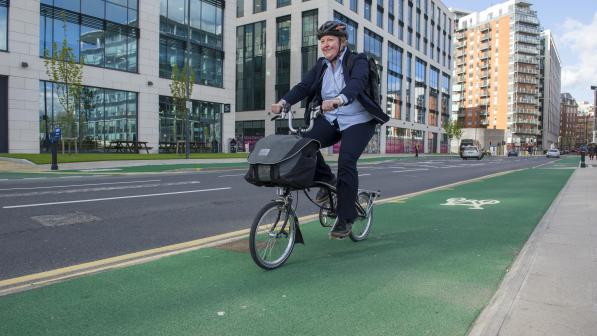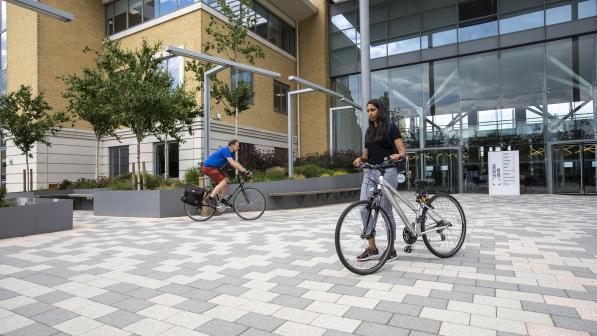Seven steps to help employers communicate with staff about cycling to work

While showers and bike parking can be some of the more obvious physical characteristics of a cycle-friendly business, there are many more steps that can be taken by an employer that are incredibly cost-effective and simple to implement.
You are sure to already communicate with your employees through many channels, but do you regularly promote the cycling options or incentives your company provides?
We've seven tips that will ensure your communications will have a positive impact on your staff and their travel choices.
1. Point the way
Often people are put off cycling for a simple reason: they don't know where to go.

Being able to navigate to work by bike could be quite challenging if employees have only previously considered the major driving routes to work. Often there are better routes that are unsuitable for car travel that are ideal for cycling, such as tow paths, traffic filtered streets, and cycle paths. Scope these out and provide your staff with maps of the local area.
While some employees may have longer journeys that could be impractical to ride every day, cycling is fantastic as a first and last mile solution as part of a longer journey. So providing maps of the route to the local train station will be welcome. Take a look at Cycling UK's Cycle to Work route planner as a practical tool to find the most suitable route; it can be used on a computer or mobile device, or you can print out turn by turn instructions for your journey.
If you have a large or complex site, consider the way-finding to the cycle parking, lockers, and showers by providing notices on doors, or signs. These will be important for cyclists, especially those who may be new to the organisation.
2. Plan ahead and do it often
By planning the communications you are sending out throughout the year, you can ensure that there is a consistent message going out to your employees and that they are receiving regular promotions and information about cycling.
You can include key activities and date such as Car Free Day in September and Bike Week in June, which will build a calendar of regular communications. Often these national activities will come with a partner pack full of materials to help you communicate these to staff too, but it may be as simple as an email, a poster or mentioning the event in an all staff meeting.
By creating a planned calendar of cycling events and content, you will ensure your communications are regularly received by employees.
3. Vary your communications
It's been around for a long time but it still has an element of truth to it; the marketing rule of seven states that a prospect needs to hear the advertiser's message at least seven times before they'll take action. Promoting cycling in your workplace is no different, so ensure that your employees are regularly communicated to about the opportunities to cycle and receive information at regular intervals and through different channels. The more times they hear about the opportunities to cycle, the bigger the chance they will give it a go.
Your workforce is likely to use digital communications, so use email and intranet posts to get the message out. But also consider a variety of touch points in other areas, with posters in rest spaces, discussions in staff meetings, and in your corporate communications channels.
4. Save money on a new bike
A cycle to work scheme is going to be beneficial to both your organisation and staff, so promoting this makes business sense. Employees who take up the scheme are more likely to feel productive, take fewer sick days and it could be good for your bottom line. When an employee takes out a bike on the cycle to work scheme, not only do they save money, but you also save 13.1% on their National Insurance contributions. It is a win – win situation.
Recent changes to the scheme also mean that employees can choose cycles that are over £1000 if you meet some criteria. This is welcome news as many adapted cycles for disabled users, electric bikes for those wanting a little help, or cargo bikes for busy families are now possible on the scheme.
If you have a cycle to work scheme offering, make sure you communicate with your employees about it regularly, including details on what the scheme is, the benefits, and practical details of how they can obtain their own bike or cycle accessories through it.

5. Get your timing right
By picking certain times in an employee's life cycle you can positively influence how they commute to work. Communicating with them at key points is likely to be have a greater effect on their behaviour, so consider when you will time your communications for the best effect.
In your inductions do you communicate the support you have for cycling at the workplace? Letting new starters know about your facilities, routes and benefits will be important for encouraging them to choose cycling from the very beginning!
Do you promote cycling at the start of spring, as we move into finer weather? Some hardy souls will cycle all year, but the British weather puts many new starters off. If you can encourage positive behaviour now, it's more likely to be habit forming and last when the weather turns later in the year.
Do you reiterate at annual reviews the cycle to work scheme your company has? Making cycling communications part of your formal processes will give it credence and encourage staff to consider their commuting choices.
Does your employee handbook mention cycle commuting? It should - this is where your staff will get their information about your organisation, so make sure all the benefits and options are available to employees.
All of these can be great times to influence behaviour and positively introduce cycling into your workplace.
6. Positive Policies
Does your workplace have a sustainable travel plan? Often travel plans are put in place for large organisations, or those under certain planning conditions, but there is nothing to stop every business having a policy to consider how their employees travel and how they can minimise their impact on the environment and maximise their health benefits.
You should consider allowing staff to have flexible working hours if you don't already. It may not seem like much, but offering employees the chance to change their commute to a time where there is less commuter traffic may be appealing for many. It can also be helpful for staff who are considering cycling to know that if their commute takes longer than expected in the first week they cycle, that they won’t be in trouble with their line manager!
If you offer mileage for cycling as well as driving for business purposes, make sure you communicate this to your staff regularly to encourage them to consider using the bike. One other area to consider is your policy towards car parking. In some businesses, we have seen policies that encourage people to drive by mandating a minimum number of business miles per month in order to keep a car parking pass. These types of policy encourage driving for the sake of driving, rather than making the individual consider how they undertake each journey.
7. Where are the local events?
Your workplace may be in an area where cycling is promoted and supported by the Local Authority, many of whom recognise that to help people to start cycling they will have to help them build their confidence. Some local authorities offer cycle skills training and maintenance training to people who live work or study in that area.
By highlighting these to your employees (and if they are not free, subsidising these courses for colleagues) the uptake will be higher, and your staff will be more confident to commute by bike.
If you do the above, you’ll be well on your way to having a thriving cycle culture at your business. If you’re not sure where to start, please feel free to contact us and we can point you in the right direction.

